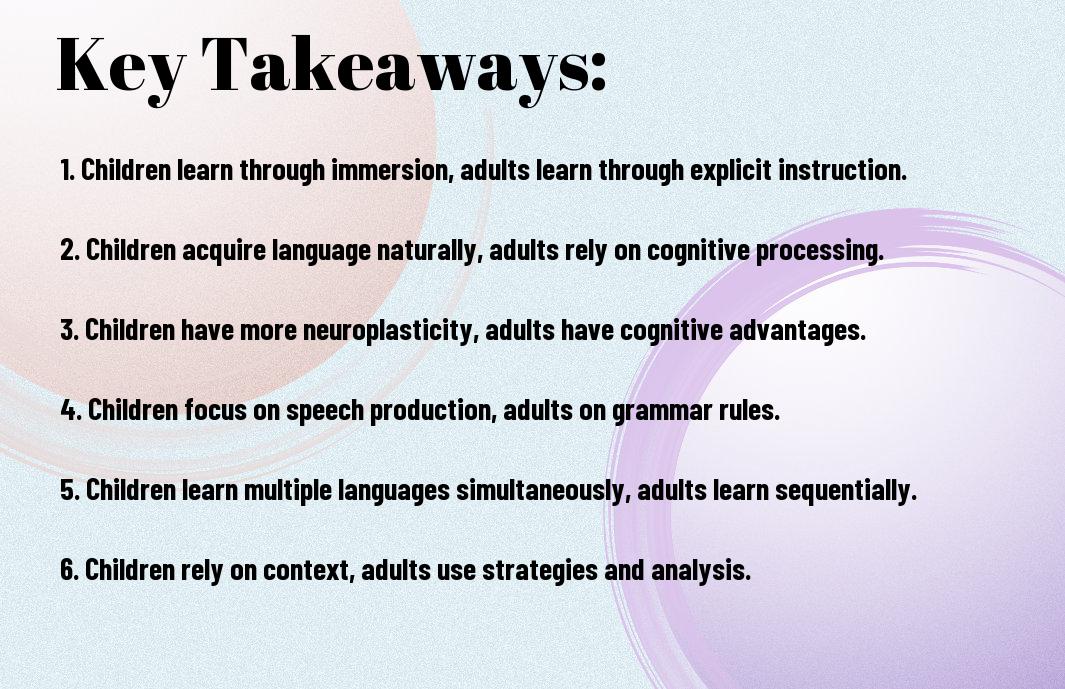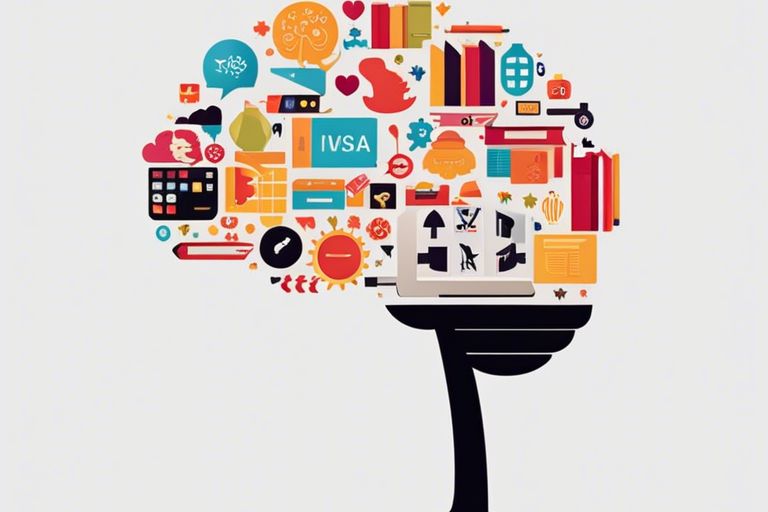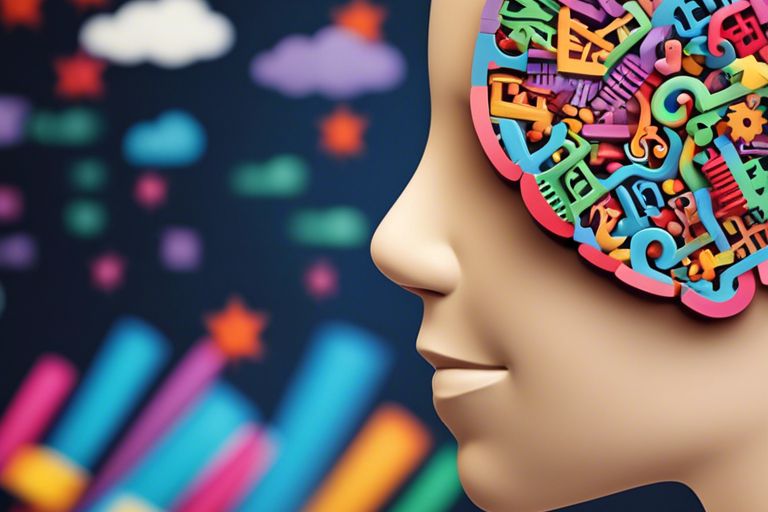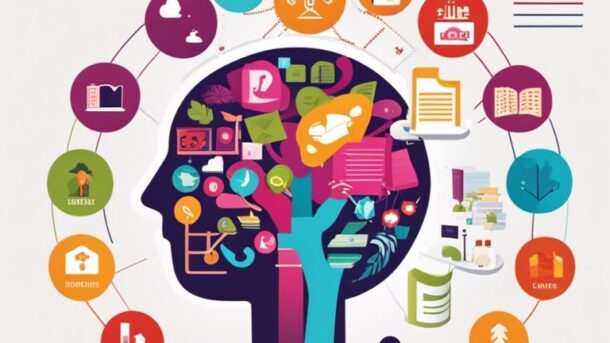Over the years, researchers have investigated into the intriguing differences in the ways children and adults learn languages. As you commence on your language learning journey, understanding these distinctions can provide valuable insights into the most effective methods for mastering a new language at different stages of life. From cognitive development to social influences, let’s explore how language acquisition varies between children and adults.
Key Takeaways:
- Critical Period: Children have a critical period for language acquisition, where they can easily learn multiple languages simultaneously, while adults may struggle with pronunciation and grammar in a second language.
- Imitation vs. Deduction: Children learn language through imitation, copying phrases and sounds they hear, while adults rely more on deductive reasoning and language rules to acquire new languages.
- Neuroplasticity: Children have a higher degree of neuroplasticity, allowing them to adapt to new languages more easily and develop native-like accents, while adults may face challenges in pronunciation due to a less flexible brain.

Language Acquisition in Children
Brain Development and Language
While the process of language learning for children and adults shares similarities, there are key differences, particularly in how the brain develops and processes language. In children, the brain is incredibly malleable and receptive to language input, making it easier for them to pick up new languages and pronunciation.
Imitation and Immersion
Children learn language through imitation and immersion in their environment. They observe and mimic the sounds, words, and phrases spoken around them, gradually forming their linguistic skills through interaction with caregivers and peers.
With their sponge-like brains, children can effortlessly absorb linguistic nuances and subtleties, often achieving a more authentic accent and fluency in a new language compared to adults. The immersive nature of their learning environment, filled with constant exposure to language cues, helps solidify their language foundation at a young age.

Language Learning Strategies in Children
There’s a distinct difference in how children approach language learning compared to adults. For children, the process often involves a lot of trial and error as they experiment with different words and phrases to convey their thoughts and ideas.
Trial and Error
An necessary strategy that children use in language learning is trial and error. They are not afraid to make mistakes and learn from them, which is crucial in the early stages of acquiring a new language.
Social Interaction and Feedback
Interaction with others plays a significant role in children’s language development. Through conversations, games, and activities with peers and adults, children have the opportunity to practice using the language in a meaningful context and receive feedback on their communication skills.
It is through these social interactions that children learn the nuances of language, such as tone, body language, and cultural expressions, which are necessary for effective communication.
The Role of Environment in Language Learning for Children
Family and Caregivers
Your family and caregivers play a crucial role in shaping your language learning abilities as a child. They are often your first language models, and the interactions you have with them form the foundation of your linguistic skills. Any exposure to diverse vocabulary, proper grammar usage, and supportive communication from an early age can significantly impact your language development. By engaging in conversations, storytelling, and reading with you, family members and caregivers contribute to expanding your language comprehension and expression skills.
Cultural and Social Influences
Children are highly influenced by the cultural and social environment in which they are raised. The languages spoken in the community, exposure to different dialects, and interactions with peers all play a part in shaping a child’s language acquisition process. Plus, cultural practices, celebrations, and traditions can introduce unique vocabulary and expressions that enrich a child’s linguistic repertoire. Providing a multicultural and inclusive environment can foster a deeper appreciation for diversity and language variation among children.
Language Learning in Adults
For a long time, there has been a debate about whether children learn languages more quickly than adults. Some studies suggest that children have an advantage when it comes to language acquisition, while others argue that adults can also be successful language learners. If you are interested in exploring this topic further, you can read more about it here.
Cognitive Approach
Cognitive theories suggest that adults may have an advantage in language learning due to their more developed cognitive abilities. As an adult, you have the ability to analyze grammatical structures, understand complex rules, and make connections between the new language and your native language. This cognitive approach allows you to approach language learning in a systematic and strategic way, which can lead to more efficient learning.
Self-Directed Learning
For adults, self-directed learning can be a powerful tool in language acquisition. Unlike children who often have structured language lessons in school, as an adult, you have the autonomy to choose how, when, and what you want to learn. This independence gives you the freedom to tailor your language learning journey to your specific goals and interests, making the process more engaging and motivating.
Approach language learning with a growth mindset, where you see challenges as opportunities for growth rather than obstacles. Set realistic goals, create a study plan, and stay consistent in your efforts. Remember that language learning is a gradual process that requires patience and persistence. By staying dedicated and embracing a positive attitude, you can achieve fluency in a new language as an adult.
Challenges Faced by Adult Language Learners
Inhibitions and Fear of Mistakes
For adult language learners, one of the significant challenges you may face is overcoming inhibitions and the fear of making mistakes. As an adult, you might feel self-conscious about sounding silly or making errors in front of others. This fear can impede your progress and hinder your willingness to practice speaking the language.
Limited Time and Motivation
Any adult language learner knows that finding time to dedicate to learning a new language can be a daunting task. With various responsibilities such as work, family, and other commitments, it can be challenging to carve out time for language study. Additionally, maintaining motivation over an extended period can be tough, especially when faced with slow progress or difficulties in grasping complex language concepts.
On top of balancing your daily responsibilities, you must find the drive and determination to stick to a consistent language learning routine. Without adequate motivation, it’s easy to push language learning to the bottom of your priority list.
Another
Another obstacle adult language learners often encounter is the tendency to rely on their native language. You may find yourself translating everything back and forth, which can hinder your ability to think and communicate directly in the new language. Overcoming this habit and thinking in the target language is crucial for fluency and proficiency.

Comparing Language Learning Processes
Not all language learners are alike, and the process of learning a new language can vary significantly between children and adults. Let’s probe into the differences in language learning processes by comparing the speed and efficiency, as well as the depth and complexity of language acquisition in these two age groups.
| Children | Adults |
| Language learning for children is often characterized by a remarkable speed of acquisition. They have an innate ability to absorb new words and grammatical structures effortlessly, often picking up languages through immersion and play. | Adults may take longer to grasp a new language compared to children. However, they can leverage their existing language knowledge and cognitive skills to understand complex language rules and nuances more quickly. |
Speed and Efficiency
Language learning for children is a natural and intuitive process that occurs rapidly. Their young brains are highly adaptable and open to new linguistic inputs, making them adept at mimicking sounds and internalizing language patterns effortlessly. On the other hand, adults may face challenges with pronunciation and accent due to cognitive and physical developmental factors.
Depth and Complexity
Language learning processes for adults often involve a deeper understanding of grammar rules, sentence structures, and cultural nuances. Adults bring their analytical skills and life experiences to the process, allowing them to comprehend the language at a more profound level compared to children.
This deeper level of understanding in adults can result in a more nuanced and nuanced language skills, enabling them to express themselves with greater sophistication and accuracy.
To wrap up
Ultimately, the process of language learning differs for children compared to adults in several key ways. Children have a remarkable ability to absorb new languages effortlessly, often through immersion and play-based activities. Their brains are wired to pick up on patterns and sounds at a rapid pace, making language acquisition a natural part of their development. On the other hand, adults may rely more on formal instruction, practice, and cognitive strategies to grasp a new language. They bring their existing knowledge and life experiences to the learning process, which can both facilitate and hinder their progress.
Despite these differences, both children and adults can successfully learn a new language with dedication and the right approach. Children may have an advantage in terms of natural language acquisition abilities, but adults have the advantage of cognitive maturity and the ability to set specific learning goals. By understanding these distinctions and tailoring your language learning approach to your own needs and learning style, you can begin on a rewarding journey towards bilingualism or multilingualism. So, whether you’re a child or an adult, don’t be afraid to look into the world of language learning – the benefits are vast and the journey is truly enriching.
FAQ
Q: How does the process of language learning differ for children compared to adults?
A: Children have a natural ability to acquire new languages effortlessly and quickly, whereas adults may find it more challenging to learn a new language due to cognitive development differences.
Q: What are some advantages children have in language learning compared to adults?
A: Children are more adept at mimicking sounds and pronunciation, they have a higher tolerance for making mistakes, and their brains are more adaptable and receptive to language acquisition.
Q: How can adults enhance their language learning process to be more similar to children?
A: Adults can incorporate immersive language experiences, practice regularly with native speakers, use language learning apps, and focus on building confidence and having a positive attitude towards making mistakes.
